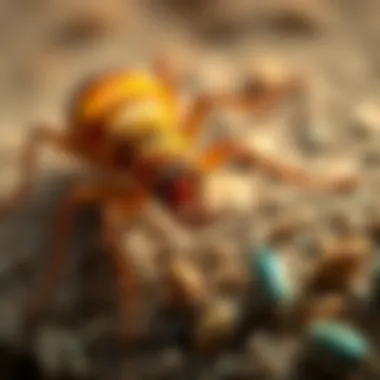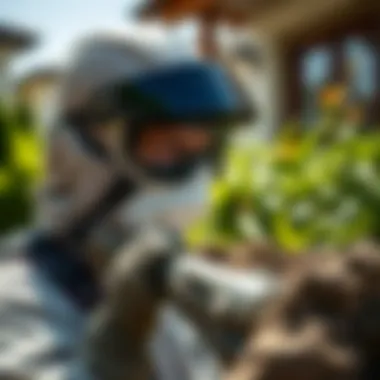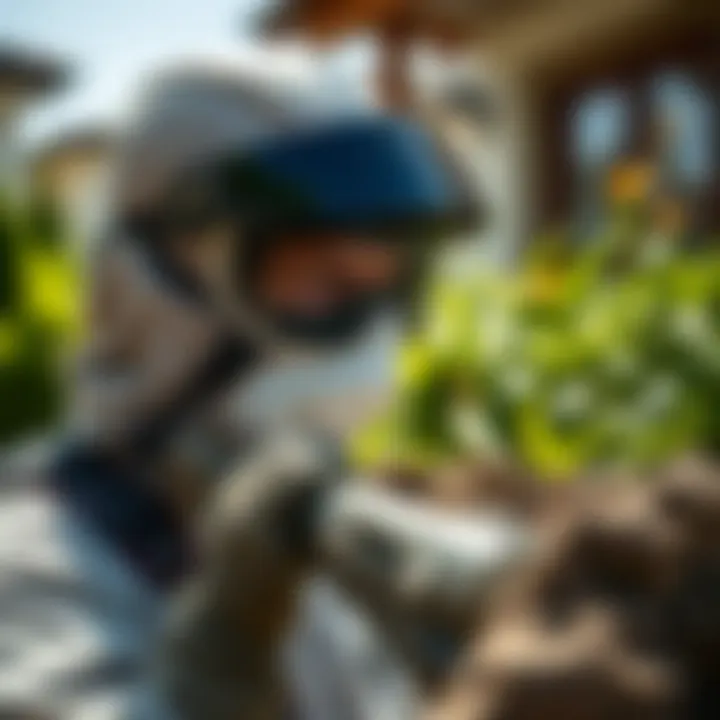Effective Pest Control Solutions for San Marcos Residents


Intro
Pest control is not just about keeping your space tidy; it’s about creating a sustainable environment for you and your family. In San Marcos, CA, the warm, inviting climate can attract a variety of pests ranging from pesky ants to unwelcome rodents. Understanding these creatures—and how to manage them effectively—is crucial for both peace of mind and the preservation of your home or business.
The goal is to provide you with reliable information on how to identify pests native to the area, the various ways to prevent infestations, and the control methods available. Let’s embark on this journey of pest management, ensuring we protect our spaces without sacrificing our health or the environment.
Understanding the Pest
Understanding pests is the first step in effective pest control. Each pest behaves differently, and knowing their patterns and life cycles can empower you to tackle them head-on.
Identification
Identifying a pest is more than just spotting it; it involves understanding its habits and characteristics. For example, many homeowners in San Marcos may encounter the common German cockroach, which is small, brown, and tends to hide in dark, warm places like kitchens. On the other hand, the pestering termite can often go undetected until critical damage is done.
Here’s a brief rundown of some common pests in San Marcos:
- Ants: Pay attention to trails and nests; these can be indicative of species.
- Rodents: Check for droppings, gnawed materials, or abnormal sounds at night.
- Termites: Look for mud tubes or discarded wings during the swarm season.
Life Cycle
Understanding a pest's life cycle can help you catch issues before they escalate. For instance, cockroaches can reproduce quickly, with females laying up to 50 eggs at a time. Termites also grow their colonies during warm months, making awareness and preventative measures all the more important.
Being attuned to these life cycles is crucial, as it allows you to time your control measures correctly, ensuring maximum effectiveness.
Pest Prevention Strategies
Once you understand the pests typically found in San Marcos, the next step involves implementing preventative strategies.
Environment Modification
Small changes in your environment can make a significant difference in pest prevention. Consider these straightforward modifications:
- Seal cracks and gaps in walls and foundations.
- Ensure food is stored in airtight containers.
- Maintain a dry environment; fix any leaks promptly.
These minor adjustments can deter many pests from making your space their home.
Physical Barriers
Sometimes, barriers can be your best friend. Installing door sweeps, window screens, and even fencing can prevent pests from entering. A well-maintained yard can also discourage pests; simply keep vegetation trimmed and avoid clutter.
Control Methods
If prevention fails and pests invade, you may need to resort to control methods. Understanding the options available can guide you to the best choice for your situation.
Chemical Control
While many homeowners resort to chemical sprays, it’s vital to use them judiciously. Targeted treatments, such as baits, can effectively manage specific pests without impacting others. Always read labels carefully and consider professional help if you’re unsure.
Biological Control
For those looking for eco-friendly alternatives, biological control incorporates natural predators. For example, introducing ladybugs can help manage aphid populations. This method lowers the chemical burden on your environment while also being effective.
If you're looking for sustainability in pest management, biological control can align well with your values. It not only curtails pest issues but also supports beneficial insect populations.
Prolusion to Pest Control in San Marcos
Pest control holds significant importance in the San Marcos area due to the unique climatic conditions and biological diversity that encourage a variety of pests. Understanding this issue not only protects your home but also contributes to the broader goal of maintaining ecological balance.
San Marcos enjoys a warm Mediterranean climate. This environment provides a perfect backdrop for pests such as ants, termites, and various insects that may invade homes and gardens. Consequently, effective pest control measures become paramount to ensure safety and comfort in households.
One of the leading concerns for homeowners is the potential damage pests can cause. Termites alone can inflict considerable damage to wooden structures, leading to exorbitant repair costs. Ants and rodents are lesser-known adversaries but can compromise hygiene and health by contaminating food and spreading diseases. Thus, a proactive approach to pest management becomes not only wise but necessary.
A multifaceted strategy is key. Homeowners should focus on prevention, early detection, and remediation. This includes understanding the behavioral patterns of pests and identifying conducive conditions that attract them. For example, securing food sources and regularly cleaning spills can significantly reduce pest activity.
"Proper pest control is a blend of prevention, awareness, and timely action. It’s essential to cultivate knowledge about what’s lurking around your home."
Moreover, the relevance of integrated pest management (IPM) practices cannot be underestimated. These practices incorporate biological, cultural, and chemical controls to effectively manage pest situations while minimizing environmental impacts.
In San Marcos, with its mix of residential areas and proximity to nature, educating yourself on local pest issues is invaluable. Utilizing resources like community programs and pest control professionals can equip you with the tools and knowledge necessary to keep your home healthy. Understanding combined tactics can ensure you remain a step ahead in safeguarding your space, leading to a peaceful, pest-free environment.
Understanding Common Pests in the San Marcos Area
Understanding common pests in the San Marcos area is essential for both homeowners and pest control professionals. The local climate, characterized by its warm Mediterranean conditions, fosters an ideal breeding ground for a variety of pests. Being aware of these nuisances helps in identifying potential infestations early, which can save homeowners both time and money by allowing for swift action. Moreover, knowledge of these pests aids in adopting preventative measures that can keep unwanted critters at bay.
In this region, the diverse ecosystem means that pests can range from microscopic nuisances to larger household intruders. By familiarizing oneself with these pests, residents empower themselves to maintain a pest-free environment effectively. Understanding their behavior, lifecycle, and habitats becomes crucial in crafting a targeted pest control strategy.


Identifying Common Household Pests
Household pests can be particularly troublesome as they invade personal spaces, often finding ways to thrive unnoticed.
Ants
Ants are a prime example of common household pests that can quickly form colonies and take over a home. These little creatures are known for their colony-based behavior, which allows them to adapt and thrive in various environments. Their key characteristic is their ability to communicate via pheromones, leading others to food sources. This behavior can escalate a minor issue into a full-blown infestation.
The unique feature of ants is their diversity; some species can actually help control other pests, while others, like the Argentine ant, can damage crops and invade buildings. The advantage of understanding ant behavior is that homeowners can employ targeted baiting techniques. However, if the infestation gets out of hand, it may require professional intervention to eliminate.
Termites
Termites pose a significant threat to the structural integrity of homes, particularly in warmer climates like that of San Marcos. These pests are famous for their wood-consuming habits. Their key characteristic lies in their phenomenal ability to consume cellulose material.
Their unique feature is that they often go undetected for years, causing extensive damage before homeowners become aware of their presence. Understanding termites is vital since preventing an infestation is simpler than dealing with the costly repairs of damaged wood. Proper inspection and treatment before building can save homeowners considerable money and trouble in the long run.
Rodents
Rodents like rats and mice can be unwelcome guests in any household. Their high adaptability to various environments makes them one of the most common pests. The key characteristic of rodents is their tendency to reproduce quickly, which can lead to an overwhelming population in a short amount of time.
Their characteristic of nocturnal behavior often keeps them hidden, making detection difficult until significant damage has occurred. This is critical because their unique feature includes the ability to gnaw through wood and wires, causing both structural and electrical hazards. Their easy access to food sources makes homes an enticing target, driving home the importance of maintaining a clean environment. Understanding their habits is essential to devising effective control strategies.
Bed Bugs
Bed bugs are infamous for their stealthy nature and blood-feeding habits during the night. These tiny insects latch onto humans, making them particularly annoying when it comes to rest. The key characteristic of bed bugs is their ability to hide in small crevices, making them tough to detect until an infestation spirals out of control.
One unique feature of bed bugs is their resilience; they can survive for months without feeding, which complicates elimination efforts. Detecting their presence is often reliant on signs like small bites on skin or identifying specks of dark spots on mattresses. The ongoing battle against these pests means that understanding their life cycle and habits can significantly impact treatment effectiveness, reducing both stress and financial burden for homeowners.
Outdoor Pests Affecting Gardens and Yards
When talking about outdoor pests, it’s often about maintaining the health of yards and gardens. Understanding which pests contribute to damage in these areas is a crucial step toward effective management.
Spider Mites
Spider mites are tiny arachnids that can create havoc in gardens by feeding on the sap of plants. Their key characteristic is their rapid reproduction capability, which can lead to widespread damage in a short period, particularly during hot weather.
A unique feature of spider mites is that they often go unnoticed until they cause visible damage, such as discoloration on leaves, making early detection vital. Their disadvantage lies in their tendency to form webs that can harm the aesthetic appeal of gardens too. Understanding spider mite behavior is beneficial for gardeners because it helps in determining the right time for intervention.
Leafhoppers
Leafhoppers are small, jumping insects that can wreak havoc on a variety of plants. Their key characteristic is their ability to transmit plant diseases, which can severely impact crop yield.
One unique feature of leafhoppers is their capacity for immediate mobility, allowing them to escape quickly from threats. They can drain vital nutrients from plants, leading to stunted growth. Awareness of their presence and life cycle can contribute significantly to timely control efforts, ensuring a thriving garden.
Snails and Slugs
Snails and slugs are notorious for their slow movements but can cause rapid damage to foliage. The key characteristic of these pests is their feeding habits; they consume leaves, flowers, and fruits, leaving substantial damage in their wake.
What sets them apart is their slimy trails, which can be both a telltale sign of their presence and a unique feature that assists their locomotion. The advantage of knowing about snails and slugs is that it encourages gardeners to implement barrier methods that can effectively keep them at bay. Understanding the preferences of snails and slugs, including their attraction to wet environments, can help in setting up an effective pest control strategy.
Pest Behavior and Biology
Understanding the behavior and biology of pests is essential for effective pest control. In San Marcos, CA, pests are abundant, and knowing what makes them tick can significantly enhance your management strategies. Both homeowners and professionals can benefit from knowledge about how pests behave, reproduce, and interact with their environment. This understanding allows for targeted control measures, leading to more successful outcomes and a healthier living space.
Life Cycles of Common Pests
Egg to Adult Stages
The life cycle of pests typically moves through distinct stages: egg, larva, pupa, and adult. This progression is crucial for comprehending how to control these unwanted visitors. For example, termites start as eggs, which hatch into larvae, and eventually mature into adults that can reproduce. Notably, by understanding these stages, it becomes easier to time interventions effectively. Knowing when to deploy treatments—like sprays or traps—can catch pests at their most vulnerable point. The particular characteristic that stands out in this cycle is the sheer speed at which many pests reproduce. Termites can produce thousands of eggs in a short time, meaning a small infestation can grow into a significant problem if not addressed promptly. For our article, focusing on these stages helps emphasize the importance of quick action when dealing with pest issues.
Understanding Reproduction Patterns
Reproduction patterns are another critical aspect of pest biology. Some species, such as bed bugs, can reproduce rapidly under favorable conditions. A single female bed bug can lay anywhere from 200 to 500 eggs during her lifetime. Recognizing the reproductive habits of pests allows homeowners to anticipate and mitigate potential outbreaks before they spiral out of control. The high reproductive rate makes it challenging to eliminate infestations without thorough management.
By learning about these patterns, one can create a more comprehensive pest control strategy that not only addresses existing pests but also prevents future infestations.
Behavioral Patterns of Household Pests
Feeding Habits
Feeding habits vary greatly among pests, affecting their impact on homes and gardens. For instances, rodents like rats and mice have insatiable appetites, often damaging property as they search for food. On the other hand, insects like ants exhibit communal feeding behaviors, which can lead to large infestations in a very short time. Understanding how pests go about their feeding can help in implementing more effective traps and baits. The distinctive way that rodents typically gnaw through various materials to find food has significant implications for property damage.
Additionally, being aware of these habits aids in modifying one's environment. Proper food storage and sanitation practices can deter many pests from invading in the first place. Thus, it’s pivotal to understand their feeding behaviors in crafting successful pest management plans.
Habitat Preferences


Pests also have specific habitat preferences that influence where they might be found. For instance, cockroaches thrive in warm, moist environments, making kitchens and bathrooms prime real estate for infestation. Understanding these preferences allows for a focused approach when monitoring for signs of these pests. Knowing where they tend to congregate or breed is invaluable for maintenance efforts and can guide homeowners in preventative measures. Unique habits, like the preference of rodents for dark and concealed spaces, can lead them to nest within walls or attics, hidden from sight. This insight can be a double-edged sword—while careful monitoring may catch infestations early, it also means that these pests can often go undetected for a time.
At the end of the day, recognizing and understanding both the feeding habits and habitat preferences of household pests creates a more informed framework for controlling them effectively. Thus, enhancing overall pest management strategies in San Marcos and ensuring homes remain pest-free.
Effective Pest Control Techniques
When dealing with pest problems, understanding effective techniques is essential for both homeowners and professionals. Effective pest control not only tackles the current infestation but also aims at preventing future issues. To achieve a pest-free environment in San Marcos, combining do-it-yourself methods with professional services can make a significant difference. This holistic approach ensures that not only the visible pests are managed but also the underlying behaviors and conditions that allow pest presence.
DIY Pest Control Solutions
Natural Remedies
Natural remedies are becoming increasingly popular among homeowners looking for safe yet effective pest control options. One significant aspect is that these remedies often use common household items, making them accessible and inexpensive. For instance, a simple mixture of vinegar and water can deter ants and other creeping pests. Natural remedies not long only minimize chemical exposure but can also be just as effective as traditional pesticides in some scenarios.
An appealing feature of natural remedies is their eco-friendly nature. Many homeowners prefer to avoid synthetic chemicals, believing they pose risks to pets and children. Furthermore, ingredients like diatomaceous earth or essential oils, notably peppermint or tea tree oil, are well-regarded for their repellent properties. However, natural solutions may require frequent application and may not work in heavy infestations, which can be a drawback.
Proper Sanitation Practices
Good sanitation practices contribute significantly to pest control, serving as a preventive measure against infestations. Naturally, pests are drawn to food, moisture, and clutter, and maintaining a clean environment dramatically reduces their attraction. Regularly vacuuming, sealing food in airtight containers, and promptly addressing spills can deter many types of pests.
The key aspect of proper sanitation is its preventative nature. Eliminating potential food sources and breeding grounds means that pests will be less likely to invade. One unique feature of these practices is the commitment required from homeowners, as maintaining cleanliness involves ongoing effort. The advantage here is clear: by being vigilant, one can often prevent infestations altogether, reducing the need for more involved pest control techniques.
Professional Pest Control Services
Evaluating Pest Control Companies
When the situation is beyond DIY methods, understanding how to evaluate pest control companies is vital. This aspect involves assessing the qualifications, experience, and reputation of service providers. A reputable company typically displays licenses and certifications, reassuring homeowners of their legitimacy.
The main characteristic of evaluating companies is to ensure they use safe and effective methods. This evaluation involves researching reviews, comparing pricing, and assessing methods used; it can help users make informed decisions. One unique feature is that personal recommendations often play a huge role—friends and neighbors who have dealt with local companies can provide insight into the reliability of services. However, a disadvantage might be the overwhelming number of options, making it tough to choose the best service efficiently.
Services Offered by Professionals
Exploring the range of services professionals offer can help homeowners decide which route to take. Many pest control experts not only handle the existing pest problems but also provide comprehensive solutions to prevent re-infestation. Services like inspections, targeted treatments, and regular maintenance plans illustrate their holistic approach.
A significant aspect is the expertise involved. Professionals know the different pest behaviors and can tailor strategies accordingly. They often use advanced technologies and methodologies that an average homeowner might not have access to. However, these services do come at a cost, and homeowners should weigh the results against their budgets. Regular communication with pest control technicians can help align expectations, ensuring the best results in pest management.
Integrated Pest Management Practices
Integrated Pest Management (IPM) is a holistic approach critical to pest control, especially in a community like San Marcos where various pests can be an insistent nuisance. This strategy emphasizes understanding pest biology and ecology to implement eco-friendly, effective control measures. Recognizing that no single method might suffice allows homeowners to minimize pesticide use while ensuring efficiency in combating pest issues.
The benefits of IPM are manifold. For one, it reduces reliance on chemical solutions, aligning with the growing inclination towards sustainability and environmental consciousness. This not only protects local ecosystems but also safeguards the health of residents and pets by lowering potential exposure to harmful substances. Furthermore, it promotes economic savings by preventing pest-related damage that might necessitate costly repairs.
Combining Biological, Cultural, and Chemical Controls
Understanding Biological Controls
Biological controls harness the power of natural predators or parasites to manage pest populations. This approach encourages a balance in the ecosystem, turning nature into an ally against unwanted pests. A hallmark of biological controls is their long-term efficiency. For instance, introducing ladybugs can help regulate aphid populations in gardens, offering a stellar alternative to chemical treatments.
Key characteristics of biological controls include their minimal environmental impact and their ability to establish a sustainable pest management framework. These methods often foster a healthier garden or yard ecosystem, promoting biodiversity. However, the establishment of these control measures can sometimes take time, requiring patience before the desired effects are noticeable.
Utilizing Cultural Practices
Cultural practices focus on modifying the environment to deter pests from thriving. This could involve practices like crop rotation, planting pest-resistant varieties, or simply maintaining cleanliness around the home to eliminate breeding grounds. The essence of this tactic lies in its simplicity and practicality; for instance, ensuring gardens are well-mulched can help reduce weed presence, cutting down on habitats for pests.
The adaptable nature of cultural practices makes it appealing for homeowners. They can be integrated seamlessly into daily routines without requiring substantial time or resources. Nevertheless, these methods have their limitations; they may not suffice for severe infestations, in which case, complementary approaches may be necessary.
Monitoring and Evaluation in Pest Management
Monitoring and evaluation serve as the backbone of any successful IPM program. These processes ensure that pest populations are kept in check and that the strategies employed are effective. By closely observing pest activity and environmental conditions, homeowners can make informed decisions about management methods.
Setting Thresholds
Setting thresholds involves determining the acceptable level of pest presence before action is deemed necessary. For example, if a garden allows a small number of weeds, it might not warrant immediate intervention. This proactive approach offers a balanced perspective and helps prevent unnecessary pesticide use.
The key advantage of establishing thresholds is that it promotes rational decision-making in pest control. It empowers homeowners to understand that not every pest sighting requires a reaction, but excessive populations should be addressed. However, the challenge lies in accurately assessing these thresholds, which can vary significantly depending on the pest and environment.
Continuous Monitoring Approaches
Continuous monitoring is about being vigilant. It involves regularly checking for signs of pests, maintaining records, and tracking patterns over time. Utilizing traps and technology can enhance this process, providing tangible data that informs control measures. Such ongoing efforts ensure that pest problems are identified early, minimizing the potential for larger infestations.
The unique benefit of continuous monitoring is its preventive nature. Early detection often leads to simpler, less invasive treatments, saving time and resources. Nonetheless, it requires a commitment to sustained observation, and for some, that consistent attention might feel overwhelming, leading to lapses in monitoring.
"Many success stories in pest management rely on the diligence of observation and timely interventions. Being proactive often means staying one step ahead of pests."
Eco-Friendly Pest Control Alternatives


In the contemporary landscape of pest management, eco-friendly alternatives have emerged as a focal point for many homeowners and professionals alike. As environmental concerns escalate, these alternatives not only provide a means to manage pest issues but do so in a way that is less harmful to the surroundings. Choosing eco-friendly methods fosters a healthier living space by minimizing chemical exposure, protecting beneficial insect populations, and contributing to sustainable practices. We will explore two significant components of eco-friendly pest control: organic methods and the promotion of beneficial insects.
Utilizing Organic Pest Control Methods
Essential Oils and Natural Pesticides
When it comes to pest control, essential oils and natural pesticides stand out for their significant role in offering a safer, less toxic alternative to traditional chemical solutions. Derived from various plants, these products possess unique properties that repel or kill pests without posing serious risks to human health or the environment. An essential quality of these oils is their natural origin, providing a comforting sense of security to those concerned about the toxicity of commercial pesticides.
For instance, neem oil, known for its insecticide and repellent qualities, is a popular choice among eco-conscious homeowners. Its unique feature is its ability to disrupt the life cycle of pests by inhibiting feeding and reproduction. However, while beneficial, one must approach their use with caution. Essential oils can sometimes cause allergic reactions or irritation in sensitive individuals, so it’s wise to test a small area before widespread application.
Biopesticides and Their Applications
Biopesticides have gained traction for their environmentally friendly properties, making them a prime concern in pest management strategies. Unlike conventional pesticides, these products utilize natural organisms or their by-products to control pest populations. A key characteristic of biopesticides is their specificity; many target only particular pests, thus preserving beneficial insects and reducing the chances of environmental harm.
For example, Bt (Bacillus thuringiensis) is utilized extensively in agriculture and gardens to combat caterpillars while leaving beneficial insects like ladybugs unharmed. The unique aspect of biopesticides is their biological base, enhancing soil health and promoting a balanced ecosystem. Nevertheless, potential disadvantages include variability in effectiveness based on environmental conditions. Prospective users need to familiarize themselves with specific applications to maximize the benefits of using these innovative products.
Promoting Beneficial Insects
Identifying Beneficial Species
When considering pest control, it's essential not only to focus on eliminating pests, but also on understanding and promoting beneficial insects. Beneficial species, like ladybugs and lacewings, play a critical role in natural pest regulation by preying on harmful pests. Identifying these species is paramount as it allows homeowners to protect them while addressing pest concerns.
For instance, encouraging the presence of predatory insects can create a natural balance in your garden ecosystem. A unique feature of this approach is its sustainability; rather than relying solely on chemical interventions, homeowners can cultivate an environment that naturally discourages pests. Without a doubt, the primary challenge is accurately identifying and distinguishing beneficial species from pests, which requires a bit of research and observation.
Creating Habitats for Beneficial Insects
Creating habitats that attract and support beneficial insects is another vital aspect of eco-friendly pest management. Homeowners can easily foster environments conducive to these insects by planting diverse flora and reducing the use of chemical pesticides. A key characteristic of this method is its dual purpose; not only does it benefit biodiversity, but it can also enhance the aesthetic appeal of gardens and yards.
Steps to creating such habitats may include planting native flowering plants and providing shelter options like small piles of stones or logs. This approach is beneficial as it encourages a thriving environment for helpful insects while effectively controlling pest populations naturally. However, a consideration to keep in mind is that it may take time for these habitats to establish and yield visible results.
"By adopting eco-friendly pest control alternatives, homeowners can play a pivotal role in nurturing their local ecosystems while managing pest populations effectively."
In summary, eco-friendly pest control alternatives encompass various methods and practices that allow homeowners to tackle pest issues while remaining environmentally conscious. Organic pest control solutions, such as essential oils and biopesticides, alongside the promotion of beneficial insects, provides a comprehensive toolkit for effective pest management. Embracing these strategies not only safeguards the environment but also fosters healthier living spaces for all.
Legal and Regulatory Considerations
Understanding the legal and regulatory frameworks surrounding pest control in San Marcos is essential for homeowners and pest management professionals alike. These regulations provide a structured approach to pest control that not only protects property but also ensures public health and environmental safety. In this section, we’ll delve into significant legal considerations that impact pest control practices and highlight their relevance.
Understanding Local Pest Control Regulations
Local pest control regulations are put in place to create a safe environment for residents and ecosystems alike. They often include guidelines on pesticide usage and the responsibilities of pest control companies.
State Guidelines
State guidelines serve as the cornerstone for pest control regulations across California. They characterize the level of acceptability regarding pest management practices in residences and commercial spaces. One significant aspect of these guidelines is their requirement for the appropriate use of pesticides, ensuring that products are registered with the California Department of Pesticide Regulation.
This attention to safety means that residents can trust that the pest control methods being utilized are effective yet pose minimal risk to inhabitants and pets. A key characteristic of state guidelines is their rigor in establishing acceptable limits for pesticide concentrations near homes and rights of way, making it a beneficial choice for those wishing to maintain a clean and safe living environment. However, navigating these regulations can be tricky, as various counties may have additional restrictions, so it pays to be well-informed.
Local Ordinances
Local ordinances take state guidelines a step further by addressing more specific issues within San Marcos. They can include bans on certain pesticides, regulations concerning the timing of treatments, or requirements related to notification before pest control measures are applied. This specificity makes them vital for ensuring community safety and fostering an understanding among residents of what pest control measures are considered safe.
The striking feature of local ordinances is their flexibility; they can evolve based on current pest pressures or community needs, making them a living part of local governance. However, this can also create complexities for pest control providers, who must stay updated on changes to ordinances. Overall, local ordinances bolster public confidence in pest management activities, reinforcing the concept of a community working together against pest pressures.
Licensing Requirements for Pest Control Professionals
To ensure that pest control is carried out by competent individuals, there are strict licensing requirements in place. Proper licensing guarantees that technicians are knowledgeable about both pest biology and safe pesticide application.
Certification Processes
The certification processes for pest control professionals include substantial training and testing. This procedure allows technicians to demonstrate their understanding of pest behavior, treatment application methods, and legal compliance. The significant aspect of these certification requirements is their emphasis on providing a standardized level of expertise among operators.
As a result, home and business owners can feel secure knowing that they are hiring responsible individuals who understand the intricacies of effective pest control. One unique feature of certification processes is the need for hands-on training, which helps ensure that technicians are not only knowledgeable but also experienced. However, the process can be time-consuming and might discourage some from entering the field, potentially contributing to a shortage of qualified professionals in certain areas.
Continuing Education for Technicians
The pest control industry is ever-evolving, with new methods and products constantly emerging. Continuing education for technicians plays a pivotal role in keeping them in the loop about the latest advancements, including environmentally friendly pest management solutions. This aspect is crucial because ongoing education helps technicians adapt to changing regulations and customer needs.
A prominent characteristic of continuing education is its periodic requirement, which ensures that licensed technicians refresh their knowledge regularly. This is beneficial as it promotes a high standard of pest control services and helps homeowners receive the best care. However, while further education is advantageous, it can also pose a financial burden for technicians, especially those working independently. Balancing the cost of education with the potential for greater customer satisfaction is a delicate task for many practitioners.
In summary, legal and regulatory considerations form the backbone of effective pest control practices in San Marcos. By understanding state guidelines and local ordinances, as well as the certification and education needed for pest control professionals, homeowners can make informed decisions about pest management. Regular updates on these frameworks ensure that pest control practices remain both effective and compliant with safety standards.
End
In contemplating the broad spectrum of pest control solutions applicable in San Marcos, it becomes clear that understanding and addressing the intricacies of pest management is paramount for homeowners.
The region is home to a diverse array of pests, each with its own unique behaviors and characteristics. Recognizing these nuances is essential for effective prevention and management. With pests like ants and termites potentially wreaking havoc on homes, it’s not merely about eliminating them but also about establishing preventive measures to avert future infestations. Thus, the integration of knowledge about pest biology and behavior plays a significant role in devising an appropriate strategy.
Moreover, the importance of utilizing eco-friendly practices cannot be understated. With a growing awareness of environmental sustainability, opting for organic pest control methods enriches the community’s health while maintaining the delicate balance of local ecosystems. Homeowners can potentially lessen their chemical footprint by promoting beneficial insects and employing natural remedies, often yielding dual benefits of pest management and enhancing the local biodiversity.
Additionally, adhering to legal and regulatory considerations is vital. Understanding state guidelines and local ordinances ensures that pest control practices remain within legal frameworks, safeguarding homeowners against possible penalties. Furthermore, choosing licensed pest control professionals who comply with required certifications highlights a commitment to quality, safety, and efficacy.







